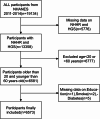Association between non-high-density lipoprotein cholesterol to high-density lipoprotein cholesterol ratio and hand grip strength in U.S. adults
- PMID: 39972018
- PMCID: PMC11840100
- DOI: 10.1038/s41598-025-90609-9
Association between non-high-density lipoprotein cholesterol to high-density lipoprotein cholesterol ratio and hand grip strength in U.S. adults
Abstract
Non-high-density lipoprotein cholesterol to high-density lipoprotein cholesterol ratio (NHHR) is an indicator of imbalance in lipid metabolism and has been associated with a variety of metabolic diseases. Hand Grip Strength (HGS) is an important indicator for assessing muscle function and overall health. The aim of this study was to investigate the relationship between NHHR and HGS, with the aim of revealing how lipid metabolism affects muscle strength and may provide an early indication of metabolic health and muscle dysfunction. We collected demographic and clinical data from 6,573 adults aged 20-60 years from the National Health and Nutrition Examination Survey (NHANES) database from 2011 to 2014.NHHR is defined as the ratio of total cholesterol minus high-density lipoprotein levels (HDL-C) divided by HDL-C. HGS is expressed as relative grip strength and is defined as the sum of the maximum readings for each hand/body mass index ratio. Among the data analysis techniques used in this study were multifactor linear regression, smoothed curve fitting, subgroups, and interactions. There was a negative correlation between NHHR and HGS in the 6573 participants included. After adjusting for all covariates, each unit increase in log2-NHHR was associated with a 0.28 [-0.28 (-0.31, -0.26)] decrease in HGS, and this negative correlation remained stable across subgroups (p < 0.01 for the test of trend). The analyses also identified a nonlinear association between NHHR and HGS with an inflection point of 1.74. Interaction tests showed that the negative correlation between NHHR and HGS differed significantly across age, gender, and stratification by diabetes status. Our study suggests that there may be a negative correlation between HGS and NHHR in adults aged 20-60 years in the U.S. Considering that a decline in HGS is an important manifestation of sarcopenia, it may be relevant to the prevention and control of sarcopenia through close detection and management of NHHR.
© 2025. The Author(s).
Conflict of interest statement
Declarations. Competing interests: The authors declare no competing interests. Ethical statement: The portions of this study involving human participants, human materials, or human data were conducted in accordance with the Declaration of Helsinki and were approved by the NCHS Ethics Review Board. The patients/participants provided their written informed consent to participate in this study.
Figures
Similar articles
-
The association between non-high-density lipoprotein cholesterol to high-density lipoprotein cholesterol ratio with type 2 diabetes mellitus: recent findings from NHANES 2007-2018.Lipids Health Dis. 2024 May 21;23(1):151. doi: 10.1186/s12944-024-02143-8. Lipids Health Dis. 2024. PMID: 38773578 Free PMC article.
-
The association between the non-high-density lipoprotein cholesterol to high-density lipoprotein cholesterol ratio and non-alcoholic fatty liver disease in US adults: a cross-sectional study.Sci Rep. 2024 Oct 22;14(1):24847. doi: 10.1038/s41598-024-76002-y. Sci Rep. 2024. PMID: 39438585 Free PMC article.
-
The association between non-high-density lipoprotein cholesterol to high-density lipoprotein cholesterol ratio and hepatic steatosis and liver fibrosis among US adults based on NHANES.Sci Rep. 2025 Feb 23;15(1):6527. doi: 10.1038/s41598-025-90773-y. Sci Rep. 2025. PMID: 39988726 Free PMC article.
-
Association between non-high-density lipoprotein cholesterol to high-density lipoprotein cholesterol ratio and sarcopenia based on NHANES.Sci Rep. 2024 Dec 4;14(1):30166. doi: 10.1038/s41598-024-81830-z. Sci Rep. 2024. PMID: 39627325 Free PMC article.
-
Hand grip strength as a proposed new vital sign of health: a narrative review of evidences.J Health Popul Nutr. 2024 Jan 9;43(1):7. doi: 10.1186/s41043-024-00500-y. J Health Popul Nutr. 2024. PMID: 38195493 Free PMC article. Review.
Cited by
-
Association of non-high-density lipoprotein cholesterol to high-density lipoprotein cholesterol (NHHR) and sarcopenia in elderly adults.Front Nutr. 2025 Jun 30;12:1614263. doi: 10.3389/fnut.2025.1614263. eCollection 2025. Front Nutr. 2025. PMID: 40661690 Free PMC article.
References
-
- Stevens, P. J. et al. Is grip strength a good marker of physical performance among community-dwelling older people? J. Nutr. Health Aging16 (9), 769–774 (2012). - PubMed
-
- Bohannon, R. W. Hand-grip dynamometry predicts future outcomes in aging adults. J. Geriatr. Phys. Ther.31 (1), 3–10 (2008). - PubMed
-
- Roberts, H. C. et al. A review of the measurement of grip strength in clinical and epidemiological studies: towards a standardised approach. Age Ageing40 (4), 423–429 (2011). - PubMed
-
- Leong, D. P. et al. Prognostic value of grip strength: findings from the prospective urban rural epidemiology (PURE) study. Lancet386 (9990), 266–273 (2015). - PubMed
MeSH terms
Substances
LinkOut - more resources
Full Text Sources
Medical



